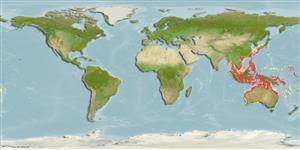Environment: milieu / climate zone / depth range / distribution range
Sinh thái học
Biển Cùng sống ở rạn san hô; Mức độ sâu 1 - 55 m (Ref. 37816). Tropical
Western Pacific: Japan to Australia, including Guam and Palau.
Bộ gần gũi / Khối lượng (Trọng lượng) / Age
Maturity: Lm ? range ? - ? cm
Max length : 30.0 cm TL con đực/không giới tính; (Ref. 3132)
Các tia vây lưng cứng (tổng cộng) : 4; Các vây lưng mềm (tổng cộng) : 8; Tia cứng vây hậu môn: 0; Tia mềm vây hậu môn: 7. Identified by the finger-like separate first rays of the ventral fins, and distinguished from the similar D. kuiteri in usually having 8 divided rays in the second dorsal fin (versus 9), the fin with a distinct horizontal pattern of lines in adults, and males have long filaments on the first dorsal fin (versus short or absent) (Ref. 48636). Body moderately depressed. Preopercular spine with processes on both inner and outer sides. Pelvic spine and 1st pelvic ray fused into an elongate rod, separated from the other pelvic rays. Attains 10 cm SL.
Lives on sand-weed bottoms (Ref. 559). Inhabits protected sand and mud flats and slopes at depths of 1 to 55 m (Ref. 37816); also include estuaries and deep water (Ref. 48636). May be seen solitary or in pairs (Ref. 90102).
Life cycle and mating behavior
Chín muồi sinh dục | Sự tái sinh sản | Đẻ trứng | Các trứng | Sự sinh sản | Ấu trùng
Masuda, H., K. Amaoka, C. Araga, T. Uyeno and T. Yoshino, 1984. The fishes of the Japanese Archipelago. Vol. 1. Tokai University Press, Tokyo, Japan. 437 p. (text). (Ref. 559)
IUCN Red List Status (Ref. 130435: Version 2024-2)
Threat to humans
Harmless
Human uses
Các nghề cá: không ích lợi (thú vị); Bể nuôi cá: Tính thương mại
Các công cụ
Special reports
Download XML
Các nguồn internet
Estimates based on models
Preferred temperature (Ref.
123201): 24.5 - 29, mean 28.1 °C (based on 1094 cells).
Phylogenetic diversity index (Ref.
82804): PD
50 = 0.7500 [Uniqueness, from 0.5 = low to 2.0 = high].
Bayesian length-weight: a=0.00794 (0.00362 - 0.01742), b=2.81 (2.63 - 2.99), in cm total length, based on LWR estimates for this (Sub)family-body shape (Ref.
93245).
Mức dinh dưỡng (Ref.
69278): 3.4 ±0.5 se; based on size and trophs of closest relatives
Thích nghi nhanh (Ref.
120179): Trung bình, thời gian nhân đôi của chủng quần tối thiểu là 1.4 - 4.4 năm (Preliminary K or Fecundity.).
Fishing Vulnerability (Ref.
59153): Low vulnerability (20 of 100).
Nutrients (Ref.
124155): Calcium = 64.2 [35.5, 96.1] mg/100g; Iron = 0.564 [0.360, 0.896] mg/100g; Protein = 18.5 [17.4, 19.4] %; Omega3 = 0.0895 [, ] g/100g; Selenium = 35 [19, 64] μg/100g; VitaminA = 85.7 [30.0, 241.4] μg/100g; Zinc = 1.4 [1.0, 1.9] mg/100g (wet weight);
